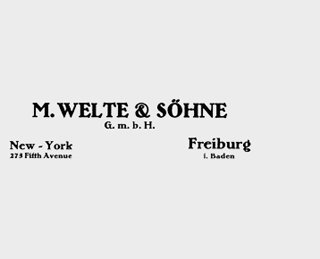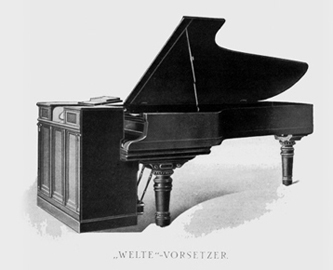Welte-Mignon Authentisch
I first came into contact with the instruments by Welte & Söhne in 1970s. From the start, I was impressed and amazed by the exuberant euphoria that buyers and musicians from 1904 until around 1932 showed for the Welte-Mignon. The names of the customers and many artists are still well-known today.
After 1950 many of the Welte rolls were copied onto records and, later also onto CDs. These sound recordings were not met with any enthusiasm from me but rather doubt. I wondered if the inventors of the Welte-Mignon, Karl Bockisch and Edwin Welte, had been magicians or clever businessmen, the spirit of that time played a part, or if they had perhaps been great inventors. How had they been able to find unprecedented recognition and unreserved praise at that time with their "creation" worldwide in all circles?
I was also greatly taken by the following report by Horst Wahl:
Berlin 1936
Horst Wahl 1 reported on a clearly optimal reproduction of Welte rolls with the co-operation of Karl Bockisch, the inventor of the Welte reproduction system:
In 1936 I recorded a large number of piano rolls for radio in a piano room at Berlin's memory church. The Steinway Welte reproduction grand piano was of extraordinarily high quality, the recording equipment was in first-class condition, and what Mr Bockisch achieved with the fine adjustment of the delicate strike-reproduction part, resulted in a reproduction more perfect than I have ever heard from the such piano rolls. When I played this recording shortly before the war to Director Wünsch of Deutsche Grammophon in 1939, he was so impressed with the reproduction of Busoni's Reisenauer's, d'Albert's and Carreño's playing etc, that he decided that I should start negotiations with Mr Bockisch in Immentalstrasse in Freiburg to bring out these treasures at DG onto records. Unfortunately, all these plans came to nothing because of the war, and with them, the last opportunity of a complete roll recording, as the Freiburg production facility was left in ruins in 1944, and the Berlin grand piano also did not survive.
And yet, I could not get away from the questions of the unsatisfactory reproduction of existing recordings with which I was familiar. Were the Welte-Mignon instruments in the decades following the "Welte era" between 1904 and 1928 not in optimal condition, the grand pianos not contemporary or had the sound technicians helped subsequently? What had been tweaked on the Welte devices, in order to play "good and consistently". Did the Welte-Mignon system really have to be checked and adjusted each time a roll was recorded?
I was also amazed that many a sound recording sounded very good, while others confirmed my doubts about the authentic reproduction.
However, the instruments being supplied worldwide at that time must have been reliable, and it was not possible for them to be constantly serviced and adjusted by technicians. My own attempts to restore Welte-Mignon devices were unsatisfactory at the start. They played, but again... questions about questions. I was only able to answer them by starting to reconstruct the conditions with instruments largely preserved in their original state.
- Horst Wahl. Die Chronik der Sprechmaschine [The Chronicle of the talking machine]. Düsseldorf 1986.





